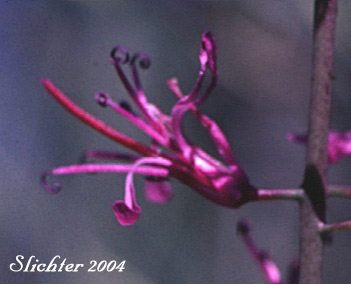
The photo above shows the spidery flower of arrow-leaf thelypody as photographed in the Malheur NF.............June 22, 2003. Note the developing silique emerging from the flower.

The photo above shows the spidery flower of arrow-leaf thelypody as photographed in the Malheur NF.............June 22, 2003. Note the developing silique emerging from the flower.
 The
photo at right shows the siliques of arrow-leaf thelypody
as photographed in the Malheur NF.............June 22, 2003. Note the spreading
pedicels and the upturned siliques with the covering slightly constricted between
seeds.
The
photo at right shows the siliques of arrow-leaf thelypody
as photographed in the Malheur NF.............June 22, 2003. Note the spreading
pedicels and the upturned siliques with the covering slightly constricted between
seeds.
Arrow-leaved thelypody is a perennial wildflower with erect stems either freely branched below or only above. The stems arise 30-60 cm and the herbage is mostly glabrous and somewhat glaucous. The basal leaves are sessile or short-petiolate, lanceolate to oblanceolate with entire to wavy margins and blades from 2-5 cm long. The numerous stem leaves are oblong-lanceolate to lanceolate in shape and measure 2-7 cm long. The margins are entire and the bases are heart-shaped and often clasping.
The racemes may resemble a corymb early in flowering, but they soon elongate into evident racemes. The pedicels are widely spreading, measuring 3-5 mm long and the bright lilac-purple sepals are narrow and widely spreading, measuring 4-5 mm long. The narrowly spatulate petals are likewise a bright lilac-purple color and measure 6-11 mm long. The stamens slightly exceed the petals. The filaments are very slender and the anthers are about 2 mm long. The fruits are slender siliques which are 3-4.5 cm long and strongly curved upwards near the base. The covering of the silique is slightly constricted between the seeds (Barely noticeable in the photo at right.).
Arrow-leaved thelypody is found in dry, open ponderosa pine forests.
Arrow-leaved thelypody is found in the Blue Mts. of Grant, Baker and Wheeler counties in Oregon, and in Idaho.
